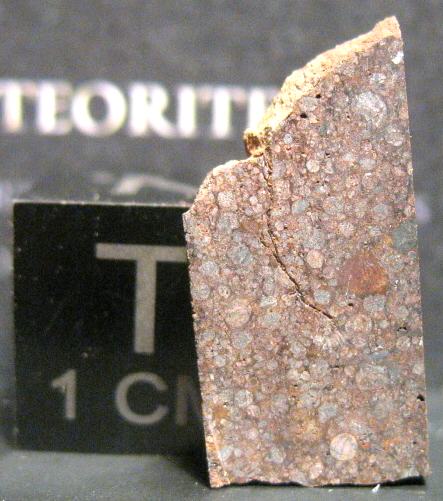NWA 7135
F3/4 (forsterite chondriteForsterite Chondrites or F-Chondrites are presently only known as inclusions in other meteorites and described by certain lithologies of the Cumberland Falls aubrite. They are thought to have derived from a small and primitive asteroid of F chondritic composition that collided with the aubrite parent body shortly after their formation Click on Term to Read More)
(highly reducedOxidation and reduction together are called redox (reduction and oxidation) and generally characterized by the transfer of electrons between chemical species, like molecules, atoms or ions, where one species undergoes oxidation, a loss of electrons, while another species undergoes reduction, a gain of electrons. This transfer of electrons between reactants Click on Term to Read More)
Purchased Oct 2010
no coordinates reported A single 51.3 g stone exhibiting a chondritic texture and lacking fusion crustMelted exterior of a meteorite that forms when it passes through Earth’s atmosphere. Friction with the air will raise a meteorite’s surface temperature upwards of 4800 K (8180 °F) and will melt (ablate) the surface minerals and flow backwards over the surface as shown in the Lafayette meteorite photograph below. Click on Term to Read More was found in the Sahara Desert. This meteoriteWork in progress. A solid natural object reaching a planet’s surface from interplanetary space. Solid portion of a meteoroid that survives its fall to Earth, or some other body. Meteorites are classified as stony meteorites, iron meteorites, and stony-iron meteorites. These groups are further divided according to their mineralogy and Click on Term to Read More became just another ‘typical’ ordinary chondriteWork in Progress Ordinary chondrites (OCs) are the largest meteorite clan, comprising approximately 87% of the global collection and 78% of all falls (Meteoritical Society database 2018)1. Meteorites & the Early Solar System: page 581 section 6.1 OC of type 5 or 6 with an apparent shock stage of S1, Click on Term to Read More placed into a bag with many others that was purchased by Fabien Kuntz at the 2010 Munich MineralInorganic substance that is (1) naturally occurring (but does not have a biologic or man-made origin) and formed by physical (not biological) forces with a (2) defined chemical composition of limited variation, has a (3) distinctive set of of physical properties including being a solid, and has a (4) homogeneous Click on Term to Read More Show. Upon closer examination, this small stone appeared to him to be an interesting unequilibrated stone, and on behalf of the Planetary Studies Foundation in Galena, Illinois, a sample was sent for analysis and classification to the University of Washington in Seattle (A. Irving and S. Kuehner). Northwest Africa 7135 was initially determined to be a unique ungroupedModifying term used to describe meteorites that are mineralogically and/or chemically unique and defy classification into the group or sub-group they most closely resemble. Some examples include Ungrouped Achondrite (achondrite-ung), Ungrouped Chondrite (chondrite-ung), Ungrouped Iron (iron-ung), and Ungrouped Carbonaceous (C-ung). Click on Term to Read More chondriteChondrites are the most common meteorites accounting for ~84% of falls. Chondrites are comprised mostly of Fe- and Mg-bearing silicate minerals (found in both chondrules and fine grained matrix), reduced Fe/Ni metal (found in various states like large blebs, small grains and/or even chondrule rims), and various refractory inclusions (such Click on Term to Read More, potentially representing a new chondritic parent bodyThe body from which a meteorite or meteoroid was derived prior to its ejection. Some parent bodies were destroyed early in the formation of our Solar System, while others like the asteroid 4-Vesta and Mars are still observable today. Click on Term to Read More (see the LPSC abstract).
National Museum of Natural History, Smithsonian Institution
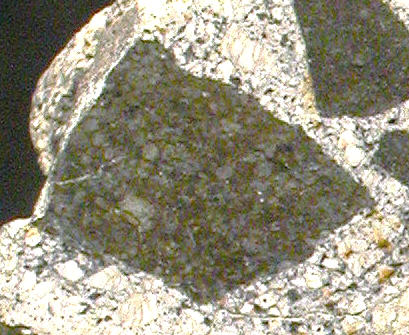
Photo courtesy of Dr. Martin Horejsi Oxygen-isotope values from six samples of NWA 7135 were obtained at the University of New Mexico (K. Ziegler), and the corresponding plots occupy a distinct space above the TFL on an oxygenElement that makes up 20.95 vol. % of the Earth's atmosphere at ground level, 89 wt. % of seawater and 46.6 wt. % (94 vol. %) of Earth's crust. It appears to be the third most abundant element in the universe (after H and He), but has an abundance only Click on Term to Read More three-isotope diagram (see below). These oxygen isotopeOne of two or more atoms with the same atomic number (Z), but different mass (A). For example, hydrogen has three isotopes: 1H, 2H (deuterium), and 3H (tritium). Different isotopes of a given element have different numbers of neutrons in the nucleus. Click on Term to Read More values provide further evidence for a unique parent body unrelated to the known ordinary chondrites.

Diagram courtesy of the Meteoritical Bulletin: Oxygen Isotope Plots Direct Link A forsteritePure* magnesium end-member (Mg2SiO4) of the olivine solid solution series and an important mineral in meteorites. When magnesium (Mg) is completely substituted by iron, it yields the the pure Fe-olivine end member, fayalite (Fe2SiO4). The various Fe and Mg substitutions between these two end-members are described based on their forsteritic (Fo) Click on Term to Read More (F) chondrite group was proposed in 1977 by Graham et al. to include the four meteorites Kakangari, Mount Morris, Pontlyfni, and Winona, along with certain inclusions in the Cumberland Falls aubrite. Subsequent chemical and O-isotope data from the Winona, Pontlyfni, and Mount Morris (Wisconsin) meteorites, and the Cumberland Falls inclusions, led to the establishment of the Winonaitea partially differentiated asteroid that was disrupted just as it began to form an Fe core and a silicate-rich crust. This disrupting impact mixed silicates into molten Ni-Fe metal forming the silicated IAB irons, and mixed olivine-rich residues of partial melts into unmelted silicates, forming the winonaites. A few winonaites Click on Term to Read More (and ‘W chondrite’) group, with evidence that its members have a genetic relationship with the IAB complex irons (e.g., Davis et al., 1977). At the same time, continued research also determined that Kakangari represents the type specimen of a unique K chondrite grouplet. The magnesian silicates in Northwest Africa 7135 are very similar to the xenolithic forsterite (Fa0.7) inclusions in Cumberland Falls (Kuehner et al., 2016), and it shares many characteristics with the anomalous chondrite Acfer 370 (see Moggi-Cecchi et al., #5421, 2009) and the ungrouped chondrite El Médano 301 (see Pourkhorsandi et al., #6176, 2016). In light of the current compositional and isotopic data, Kuehner et al. (2015, 2016) along with Pourkhorsandi et al. (2016, 2017) have recognized that NWA 7135, Acfer 370, El Médano 301, and the inclusions in Cumberland Falls (and in the ALHA78113 aubrite) represent a ‘new’ F chondriteForsterite Chondrites or F-Chondrites are presently only known as inclusions in other meteorites and described by certain lithologies of the Cumberland Falls aubrite. They are thought to have derived from a small and primitive asteroid of F chondritic composition that collided with the aubrite parent body shortly after their formation Click on Term to Read More grouplet. They demonstrated that NWA 7135 and the other members of this F chondrite grouplet are clearly resolved from other ordinary chondrite reservoirs and form a cluster on an oxygen three-isotope diagram. Values for NWA 7135 and the other forsteritic meteorites and inclusions overlap and establish a unique trend line between the ordinary chondrites and the TFL (see diagrams below).
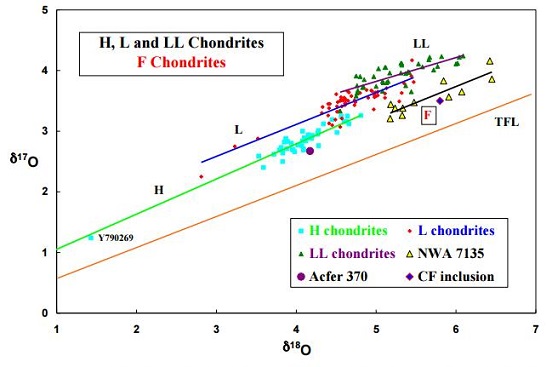
Diagram credit: Kuehner et al., 78th MetSoc, #5238 (2015)
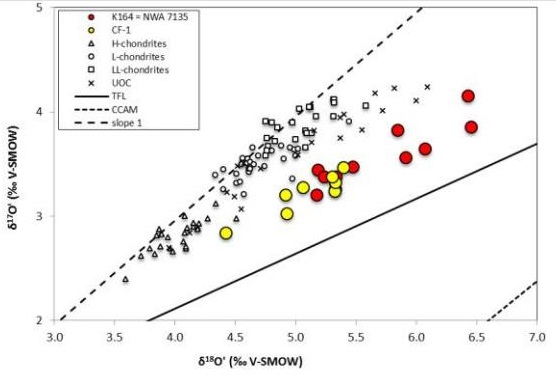
Diagram credit: Kuehner et al., 47th LPSC, #2304 (2016)
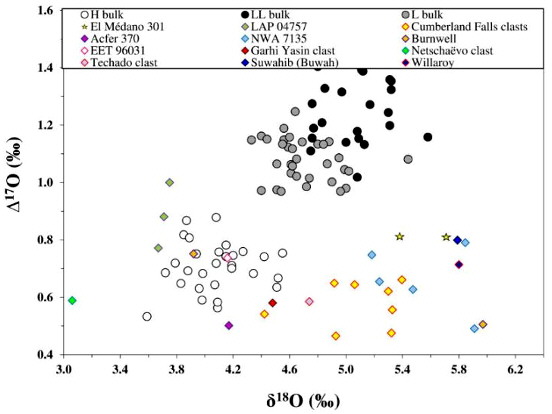
Diagram credit: Pourkhorsandi et al., GCA, vol. 218, p. 109 (2017)
‘The ungrouped chondrite El Médano 301 and its comparison with other reduced ordinary chondrites’
(https://doi.org/10.1016/j.gca.2017.09.013) An early Solar SystemThe Sun and set of objects orbiting around it including planets and their moons and rings, asteroids, comets, and meteoroids. history for the F chondrite parent body was suggested by Neal and Lipschutz (1981). Their scenario involves formation of both the F chondrite and enstatiteA mineral that is composed of Mg-rich pyroxene, MgSiO3. It is the magnesium endmember of the pyroxene silicate mineral series - enstatite (MgSiO3) to ferrosilite (FeSiO3). Click on Term to Read More planetesimalsHypothetical solid celestial body that accumulated during the last stages of accretion. These bodies, from ~1-100 km in size, formed in the early solar system by accretion of dust (rock) and ice (if present) in the central plane of the solar nebula. Most planetesimals accreted to planets, but many – Click on Term to Read More in close proximity within the solar nebulaThe primitive gas and dust cloud around the Sun from which planetary materials formed.. Thereafter, a severe collision between these two objects occurred, during which time F chondrite material became incorporated in the regolithMixture of unconsolidated rocky fragments, soil, dust and other fine granular particles blanketing the surface of a body lacking an atmosphere. Regolith is the product of "gardening" by repeated meteorite impacts, and thermal processes (such as repeated heating and cooling cycles). Click on Term to Read More of the enstatite planetesimal. This scenario is supported by their identification of shock-generated plagioclaseAlso referred to as the plagioclase feldspar series. Plagioclase is a common rock-forming series of feldspar minerals containing a continuous solid solution of calcium and sodium: (Na1-x,Cax)(Alx+1,Si1-x)Si2O8 where x = 0 to 1. The Ca-rich end-member is called anorthite (pure anorthite has formula: CaAl2Si2O8) and the Na-rich end-member is albite Click on Term to Read More and jadeitic pyroxeneA class of silicate (SiO3) minerals that form a solid solution between iron and magnesium and can contain up to 50% calcium. Pyroxenes are important rock forming minerals and critical to understanding igneous processes. For more detailed information, please read the Pyroxene Group article found in the Meteoritics & Classification category. Click on Term to Read More grains in the Cumberland Falls inclusions. In addition, Cumberland Falls exhibits shock effects from this collision, which include the presence of miniscule blebs of metallic FeNi and sulfide dispersed in the silicateThe most abundant group of minerals in Earth's crust, the structure of silicates are dominated by the silica tetrahedron, SiO44-, with metal ions occurring between tetrahedra). The mesodesmic bonds of the silicon tetrahedron allow extensive polymerization and silicates are classified according to the amount of linking that occurs between the grains producing silicate darkening, undulose to mosaic extinctionIn astronomy, the dimming of starlight as it passes through the interstellar medium. Dust scatters some of the light, causing the total intensity of the light to diminish. It is important to take this effect into account when measuring the apparent brightness of stars. The dark bands running across portions Click on Term to Read More with planar fractures in olivine, impact-melt clasts, and a shock stageA petrographic assessment, using features observed in minerals grains, of the degree to which a meteorite has undergone shock metamorphism. The highest stage observed in 25% of the indicator grains is used to determine the stage. Also called "shock level". Click on Term to Read More of S2–S3 (A. Rubin, 2010). Ultimately, this enstatite parent body experienced another impact event through which ejectaFractured and/or molten rocky debris thrown out of a crater during a meteorite impact event, or, alternatively, material, including ash, lapilli, and bombs, erupted from a volcano. Click on Term to Read More eventually became the Cumberland Falls aubrite. Other collisional ejecta eventually crossed paths with the Earth, which was recovered and subsequently classified as E- and F-group chondrites and aubrite meteorites. Northwest Africa 7135 exhibits features of moderate weathering (W2) and very weak shock (S2). Notably, a forsterite chondrite/achondrite clastA mineral or rock fragment embedded in another rock. Click on Term to Read More with EH3 affinities has been discovered in the EH3 chondrite Sah 97158, paired with Sah 97096 (Boyet et al., 2011, #5120). The specimen of NWA 7135 shown above is a 0.58 g partial slice. The photos below show the complete meteorite as found and the cut face of the main massLargest fragment of a meteorite, typically at the time of recovery. Meteorites are commonly cut, sliced or sometimes broken thus reducing the size of the main mass and the resulting largest specimen is called the "largest known mass". Click on Term to Read More, courtesy of Fabien Kuntz.
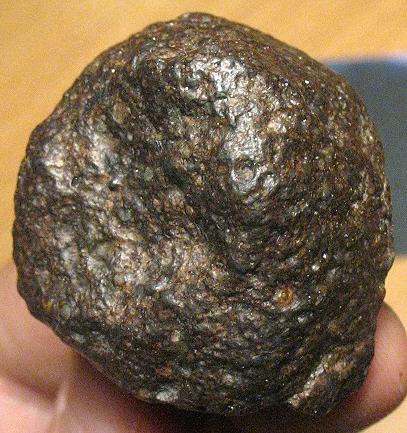
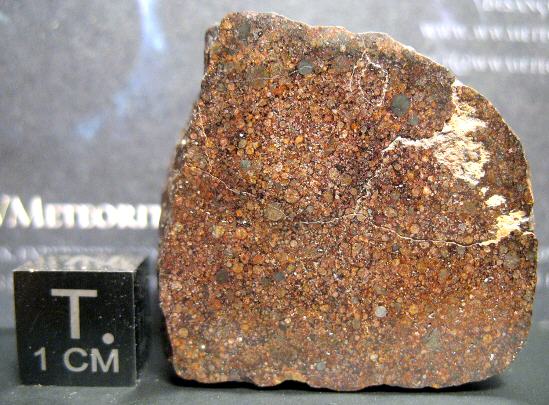
Photos courtesy of Fabien Kuntz






